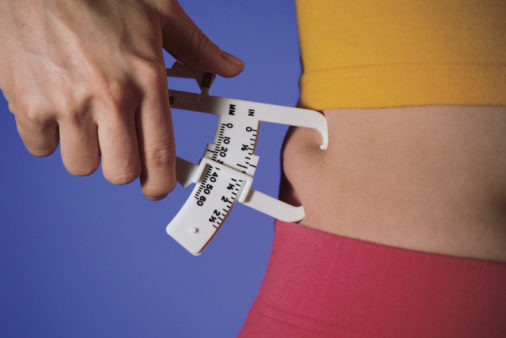In our health-conscious society, the idea that thin equals healthy has been engrained into most people’s minds. However, thin does not always equal fit, and overweight or obese doesn’t automatically equate to unhealthy.
Confused? Well, a major indicator of health is something called visceral fat, which is abdominal fat or fat that is stored around the organs in the abdominal cavity. Such organs could include your liver, pancreas, stomach, intestines, kidney and other organs (1). Visceral fat is not visible from the outside, like subcutaneous fat (i.e., fat that is stored directly under the skin and causes bulging and flab) but it can be harmful (2).
Visceral Fat Explained
What causes these fat deposits to form around your organs? There are many factors, such as poor diet, lack of exercise, lack of sleep and aging.
Jimmy Bell, Ph.D., a professor of molecular imaging at Imperial College, London, has been studying this subject for years. He has found that people who watch their diet but do not exercise regularly have higher amounts of visceral fat (1). This could be a reason why even some thin people have so much of this dangerous fat. They might be eating a diet high in sugars and fats that they don’t work off with exercise, but they are still eating too little to cause major weight gain (1).
On the flip side, there has been evidence that shows that obese sumo wrestlers may be healthier than the average thinner person. This is because of the amount of exercise they do, compared to the average sedentary person. Most of sumo wrestlers’ fat is subcutaneous, and not embedded around their vital organs (1).
Health Hazard
There are many dangers associated with having high amounts of visceral fat. It increases the risk of hypertension, high serum triglycerides, abnormal secretion of adipocytokines (3), insulin resistance, type-2 diabetes and heart disease (1). One study has connected visceral fat with metabolic risk factors in older adults. The study concluded that the more visceral fat a person had, the more metabolic risks they suffered from. (3)
Preventing the Problem
There are many things that can be done to ward off visceral fat. Get the recommended amount of exercise per week, including activities like yoga that reduce stress (4). Eat a diet high in protein (4) and dietary fiber (5) and low in saturated fat and sugar (4).
What about supplements? Studies on the connection between supplements and visceral fat are relatively new, but there is some evidence that suggests some supplements can help.
• Calcium: Studies have shown that people who try to lose weight while consuming a lot of calcium will lose more abdominal fat than those who don’t consume enough calcium (5). A study conducted at the University of Copenhagen and Aarhus found that subjects who increased their calcium intake from 700 mg/day to 2,300 mg/day more than doubled their fat loss (6).
• Krill oil: One study found that long-chain polyunsaturated fatty acids found in krill oil can change membrane fatty acid composition. Obese rats used in the study were found to have significantly improved ectopic fat deposition and susceptibility to inflammation after consuming krill oil for four weeks. They also had lower levels of triacylglycerol concentrations in their heart and liver (7).
• Licorice extract: This extract has been shown to increase enzymes that contribute to burning fat, and prevents fat synthesis in the liver. One study found that over eight weeks, visceral fat in people taking licorice supplements decreased by up to 10% (8).
• Brown seaweed/pomegranate combination: This has been shown to reduce fat around the liver, which typically precedes weight loss, as well as improve metabolic rate and lower LDL cholesterol. A 16-week study conducted by the National Academy of Natural Sciences in Moscow found that taking a supplement composed of brown seaweed and pomegranate seed oil caused 150 female subjects to average of seven to eight pounds of fat loss. Most of the fat lost was from the abdominal area, and the women also had lower levels of triglycerides and liver lipids (9). WF
References
1. MSNBC.com, “Thin People Can Be Fat On The Inside,” May 11 2007, www.msnbc.msn.com/id/18594089/ns/health-fitness, accessed Jan. 26, 2011.
2. J. Bennett, “The Deadly Tag Team of Belly Fat and High Blood Pressure,” Hive and Health Media, Jan. 25, 2011, www.hivehealthmedia.com/deadly-tag-team-of-belly-fat-and-high-blood-pressure, accessed Jan. 26, 2011
3. K. Nomura, et al., “Visceral Fat Accumulation and Metabolic Risk Factor Clustering in Older Adults,” J. Amer. Geriatrics Soc., 58, 1658–1663 (2010).
4. D.F. Facet, “How to Know if You’re Skinny-Fat: Normal Weight Obesity,” Mar. 26, 2010, www.associatedcontent.com/article/2822776/how_to_know_if_youre_skinnyfat_normalweight_pg2.html?cat=5, accessed Jan. 26, 2011.
5. K. Uzoma, “Natural Remedies to Remove Belly Fat,” Jan. 4, 2011,www.livestrong.com/article/349052-natural-remedies-to-remove-belly-fat/#ixzz1CAHJxe4l, accessed Jan. 26, 2011.
6. “Calcium: the Milk of Human Weight Loss,” Food Manufacture [serial online], January 2009, accessed via Ebsco. Jan. 28, 2011.
7. B. Batetta, M. Griinari and G. Carta, “Endocannabinoids May Mediate the Ability of (n-3) Fatty Acids to Reduce Ectopic Fat and Inflammatory Mediators in Obese Zucker Rats,” J. Nutr. 139 (8), 1495–1501.
8. L. Swanson, “Attack Visceral Fat with a New, Groundbreaking, Nutrigenomic Supplement,” Swanson Health Products, www.swansonvitamins.com/health-library/products/glavonoid-licorice-flavonoid-oil-attacks-visceral-belly-fat.html, accessed Jan. 26, 2011.
9. Livestrong, “Brown Seaweed Causes Weight Loss,” Oct. 13, 2010, www.livestrong.com/article/278623-brown-seaweed-causes-weight-loss, accessed Jan. 28, 2011.
Published in WholeFoods Magazine, June 2011










